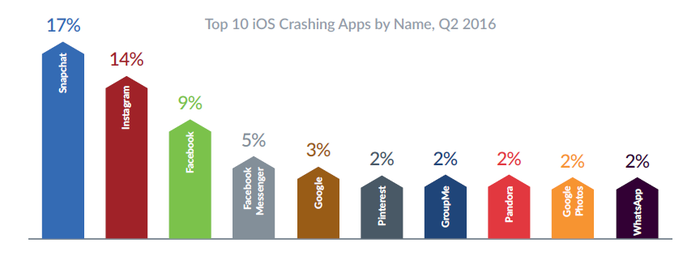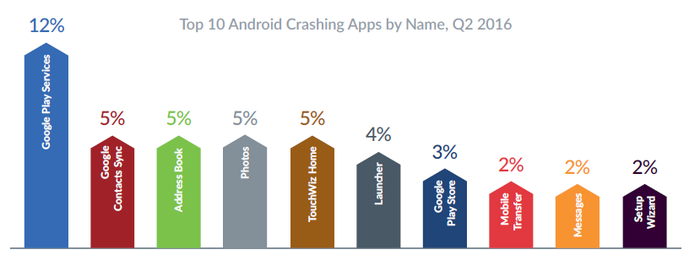iOS performance falls behind Android as app failure rates double
Research from mobile device diagnostic firm Blancco Technology has revealed Apple has lost out to Android in the battle for smartphone performance, as app failure rates more than doubled across Q2.
August 25, 2016

Research from mobile device diagnostic firm Blancco Technology has revealed Apple has lost out to Android in the battle for smartphone performance, as app failure rates more than doubled across Q2.
The Q2 State of Mobile Device Performance & Health report iOS apps crashed on 50% of iOS devices tested compared to just 23% of Android devices with Snapchat, Instagram and Facebook the most likely culprits of the crash on iOS. Overall the failure rate for Apple devices more than doubled from 25% in Q1 to 68% in Q2 2016, while Android had a more positive time with failure rates reaching 35%, down from 44% in the same period.
“Based on what our data found, I would have to say the iOS software updates that were released during Q2 2016 – specifically iOS 9.3, iOS 9.3.1 and iOS 9.3.2 – played a considerable part in how iPhones performed during that period,” said Richard Stiennon, Chief Strategy Officer at Blancco Technology. “If you look at how frequently Apple released each of those updates – in some cases, weeks or just one month after the previous release – you have to wonder what drove them to push out so many updates in such short bursts of time.
“There’s this unspoken assumption among users that when they install a new version of software, their devices will absolutely perform better. But that’s just not true – it’s not a given. Sometimes a software update can cause collateral damage and lead to a variety of performance issues. But not all users are tech and mobile device experts – so they don’t know this.
“I usually wait to let other users install the update on their devices and then head to user forums, tech blogs and elsewhere to see how the software update is performing and what types of issues and complaints are arising from it. So in the case of the iOS 9.3.1 and iOS 9.3.2 software updates that were released in April and May 2016, respectively, I waited, read, listened to what other users were experiencing from them – faster battery drains, random crashes, WiFi connectivity problems and poor sound quality. And for that reason, I decided not to install the updates to my iPhone.”
When looking more specifically at the performance issues for the iOS, crashing apps, WiFi and head set arose as the three most common sources of failures, accounting for 65%, 11% and 4% respectively. Apple released its iOS 9.3, iOS 9.3.1 and iOS 9.3.2 software updates in March, April and May to fix bugs users were experiencing, though these updates would appear to have caused more problems than offered solutions. According to the data, apps crashed on 50% of iOS devices which were tested over the course of the quarter, though Android was not perfect either.
Apps did cause 23% of the Android devices tested over the period to crash, with Google’s own apps taking the majority of the blame. Google Play Services, Google Contacts Sync and the address book were the guilty parties here, while contrary to iOS, social media apps did not cause many problems. Samsung was the worst offender in terms of specific device failure rates, with budget-friendly smartphone brands Lenovo LeTV taking second and third positions. But what is the explanation behind the improved performance for Android?
“I can’t profess to have the exact answer to this. But I can look at a few factors that could have caused this,” said Stiennon. “For one, there are variances in smartphone OS market share each quarter. While Android’s market share rose significantly in certain markets like EU5, China, Japan and Australia, it declined in the US. So as less Android devices were being sold in the US, in particular, it’s likely that less device issues were then detected.
“Another reason Android failure rates have dropped consistently each quarter since we began analyzing mobile diagnostics testing data is that users are adapting and improving their device usage to keep their devices running smoothly. Or they could be doing their research and homework by visiting online mobile/tech blogs, Android user forums and other sites to get tips on how to optimize their device’s performance.”
Despite iOS showing higher rates of failure, the team might be able to get away from too much public outcry, as unlike on Android devices, the user is not made aware as to when an app crashes. Irrelevant as to whether the app is operating in the background or not, Android users see an on-screen pop-up when an app crashes. iOS users may not be aware the number of times an app crashes over the course of the day.
The report is unlikely to come as welcome news to Apple execs as the team inches towards the release of the iPhone 7 next month. The most prominent announcement which has leaked out in the build up to the launch is the removal of the headphone jack, though as the model has not been into end users’ hands yet, it remains to be seen what impact this will have on performance.
Outside of Apple, improvements will be needed as failure rates could be perceived as high. With the global smartphone in a continued slump, and consumers becoming more price conscious, the budget smartphone market is set to grow. According to Strategy Analytics, the budget smartphone market could account for as much as 25% of demand by 2017, finding traction in emerging markets such as India. For the premium brands, to remain competitive there has to be an edge. Failure rates which are listed in the report are unlikely to help in the battle against growing budget brands.


About the Author
You May Also Like












_1.jpg?width=300&auto=webp&quality=80&disable=upscale)
